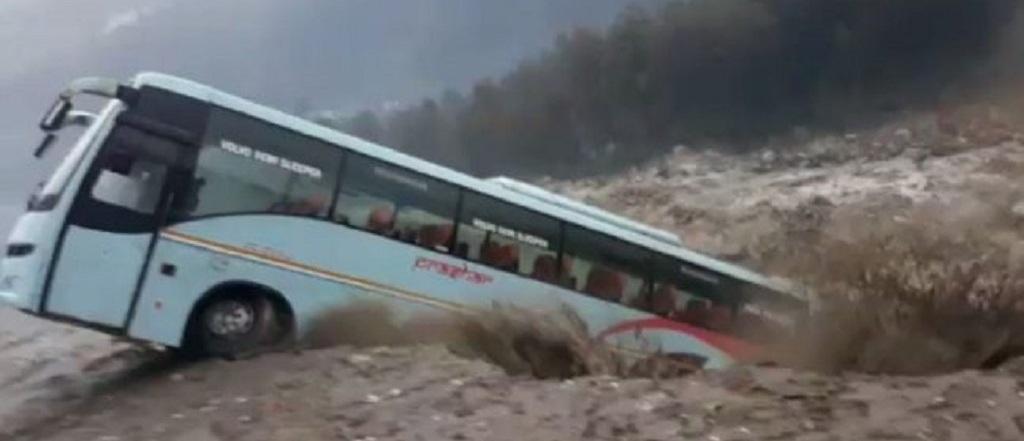

The hill state got 15 times its normal rainfall on Sunday owing to a depression settled over west MP and east Rajasthan



It’s Himachal Pradesh’s turn now! It has become the 16th state in the country to suffer from floods this monsoon. Flash floods in the Himalayan state have damaged roads blocking many of the national highways in Shimla, Mandi, Kullu and Kinnaur districts. The Indian Meteorological Department (IMD) predicts more heavy rainfall in the state on September 24 which might continue into September 25.
On September 23, the hill state received 15 times the rainfall it normally does at this time of the year, according to the IMD. Nine out of 12 HP districts have received more than 10 times its normal rainfall. Una district received the highest absolute rainfall of 124.2 mm which is 21 times its normal rain record and Kullu got 97.6 mm rain, which is almost 40 times more.
But, what brought about this unusual amount of rainfall?
A depression formed over south west Madhya Pradesh on September 22 moved in the north-west direction and settled into a low pressure area over west Madhya Pradesh and east Rajasthan. This brought heavy rains to Himachal Pradesh, Punjab, east Rajasthan, west Madhya Pradesh and Gujarat on September 23. The IMD predicts this weather system will move northwards and interact with a low pressure area created by westerly winds bringing heavy rainfall to Himachal Pradesh and Uttarakhand on September 24.
Dependency on natural resource
During the current floods, a video of a Volvo bus being swept away by the flooded Beas River in Manali has captured both media headlines and people’s imagination. But floods such as this, caused by heavy rainfall in a short span of time, also have long terms effects on a region. The Himalayan region is especially vulnerable to such events owing to its dependence on natural resource-based economic activity such as agriculture and tourism. For example, in Himachal Pradesh, 70 per cent employment is provided by agriculture and this number goes up to 95 per cent in the case of rural female workers, according to an Asian Development Bank (ADB) report on climate change in Himachal Pradesh. Moreover, only 10 percent of the total area of the state is under cultivation and 92 per cent of land holdings are small or marginal. The average land holding is also only 1.2 hectares. Such fragmentation of land further increases the vulnerability of the farmers to weather extremes.
Also, there is the looming danger of climate change which will have a major impact on the farm economy in Himachal Pradesh, say scientists. Increased frequency of heavy rainfall, like the state is witnessing right now, can potentially damage crops and cause soil erosion that can decrease the fertility of farmlands.
Rainfall patterns
Change in rainfall patterns can also impact non-irrigated crops. The state has already witnessed climate induced changes like “loss of tree species, drying of traditional water sources, changes in bird types and populations, reduction in crop yields, and increased vulnerability of winter cropping due to changes in rainfall patterns and planting dates”, notes the ADB report.
The Indian Council of Agricultural Research (ICAR) estimates that under medium-term climate change predictions there will be a decrease in crop yields between 4.5 to 9 per cent by 2039. For Himachal Pradesh, the ICAR has observed a reduction in the area under Apple orchards and a shifting of the orchards from lower altitudes (1200-1800 msl) to higher altitudes (2400-2800 msl). The apple orchard yields dipped in Shimla, Kullu and Lahaul and Spiti districts in the mid 2000s by 2-3 percent.
A study conducted by the State Centre on Climate Change in Himachal Pradesh found a downward trend in the yield of maize crops with irregular, less and untimely rainfall in all the districts of the state. Similar observations were made for other cereal crops like rice and wheat as well.
We are a voice to you; you have been a support to us. Together we build journalism that is independent, credible and fearless. You can further help us by making a donation. This will mean a lot for our ability to bring you news, perspectives and analysis from the ground so that we can make change together.

Comments are moderated and will be published only after the site moderator’s approval. Please use a genuine email ID and provide your name. Selected comments may also be used in the ‘Letters’ section of the Down To Earth print edition.